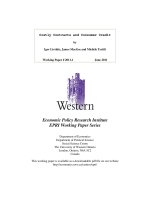WORKING PAPER SERIES ON REGIONAL ECONOMIC INTEGRATION NO. 22: India’s Bond Market— Developments and Challenges Ahead docx
Bạn đang xem bản rút gọn của tài liệu. Xem và tải ngay bản đầy đủ của tài liệu tại đây (444.19 KB, 56 trang )
WORKING
PAPER SERIES
ON REGIONAL
ECONOMIC
INTEGRATION NO. 22
India’s Bond Market—
Developments and Challenges
Ahead
Stephen Wells and Lotte Schou-Zibell
December 2008
Stephen Wells
+
and Lotte Schou-Zibell
++
India’s Bond Market—
Developments and Challenges
Ahead
+
Stephen Wells is a senior research fellow, at the ICMA Centre, University
of Reading. E-mail: , Tel: 44 1268 741541.
++
Lotte Schou-Zibell is a senior economist in the Ofce of Regional
Economic Integration at Asian Development Bank. E-mail: lschouzibell@
adb.org, Tel: 632 632 5245, Fax: 632 636 2183.
December 2008
The ADB Working Paper Series on Regional Economic Integration focuses on topics relating to regional cooperation
and integration in the areas of infrastructure and software, trade and investment, money and finance, and regional
public goods. The Series is a quick-disseminating, informal publication that seeks to provide information, generate
discussion, and elicit comments. Working papers published under this Series may subsequently be published
elsewhere.
Disclaimer:
The views expressed in this paper are those of the author and do not necessarily reflect the views and policies of the
Asian Development Bank or its Board of Governors or the governments they represent.
The Asian Development Bank does not guarantee the accuracy of the data included in this publication and
accepts no responsibility for any consequence of their use.
Use of the term “country” does not imply any judgment by the authors or the Asian Development Bank as to the legal
or other status of any territorial entity.
Unless otherwise noted, $ refers to US dollars.
© 2008 by Asian Development Bank
December 2008
Publication Stock No. WPS090038
Contents
Abstract 1
I. Introduction 2
II. Development and Outlook: Illiquid and Lagging, but Growing 2
III. Government Bonds: Reforms Proceed, Development Lags 14
A. Key Developments 14
B. Reforms 17
IV. Corporate Bonds: Transparency Improves, But Development Still
Lags 23
A. Key Developments 23
B. Factors Limiting the Further Development of Corporate Bond
Markets 24
V. Securitization: Early Starter Awaits Take Off 30
A. Banks and Insurance Companies: Predominant Investors in
Securitized Notes 32
B. Reforms 33
VI. Regulation Hampers Participation 34
A. Life Insurance Sector 34
B. Pension Funds 35
C. Mutual Funds 36
D. Foreign Investors 36
E. Investor Diversity 37
VII. Rationalizing Regulatory Structures 38
A. Measures to Address Bond Market Liquidity 38
B. Measures to Develop the Corporate Bond Market 40
VIII. Conclusion: Learning From Neighbors 41
References 42
ADB Working Paper Series on Regional Economic Integration 45
Boxes
Box 1: Reforming Finance for Development 12
Tables
1. India and EEA Bond Markets (% of GDP), March 2008 4
2. India and EEA Bond Markets (in US$ billion), March 2008 7
3. Government Bonds – Days Traded (Aug 2007 – July 2008) 9
4. Indian Credit Rating Agencies 24
5. Distribution of Corporate Bonds Issued by Rating 29
Figures
1. Financial Sector Development in India 3
2. Equity Market Capitalization (% of GDP) 5
3. Bank Assets (% of GDP) 5
4. Government Bonds (% of GDP) 6
5. Corporate Bonds (% of GDP) 7
6. India and EEA Government Securities Turnover (% Average
Outstanding) 8
7. Government Securities Turnover 9
8. Corporate Bond Turnover 10
9. Indian and EEA Corporate Bonds Turnover (% of Average
Outstanding) 11
10. Indian Government Market Borrowing 14
11. Government Borrowing for Deficit Financing 15
12. Indian Government Debt by Maturity 16
13. NDS-OM Market Share of Government Securities Trading 17
14. Repo and CBLO Volumes 20
15. Private Placement Issues 25
16. Value of Private Placements by Issuer Type (2006/07) 26
17. Number of Private Placements by Issuer Type (2006/07) 27
18. Deposits, Investments, and Advances by Bank Type (2007-08) 27
19. Structured Finance 31
20. India and EEA Securitization (% of GDP), 2001 31
21. India and EEA Securitization (% of GDP), 2007 32
22. Holdings of Government Bonds by Investor Groups
(%, end-March) 35
Abstract
While India boasts a world-class equity market and increasingly important bank assets, its bond
market has not kept up. The government bond market remains illiquid. The corporate bond
market, in addition, remains restrictive to participants and largely arbitrage-driven. Securitization,
which once had the jump on other Asian markets, has failed to take off.
To meet the needs of its firms and investors, the bond market must therefore evolve. This will
mean creating new market sectors such as exchange-traded interest rate and foreign exchange
derivatives contracts. It will mean relaxing exchange restrictions, easing investment mandates
on contractual savings institutions, reforming the stamp duty tax, and revamping disclosure
requirements for corporate public offers. This paper reviews the development and outlook of the
Indian bond market. It looks at the market participants—including life insurance, pension funds,
mutual funds and foreign investors—and it discusses the importance to development of learning
from the innovations and experiences of others.
Keywords: India, emerging East Asia, bond market, securitization, collateralized borrowing and
lending obligations (CBLO)
JEL Classification: F3, G2, K2, O5
2
I. Introduction
The Indian financial system is changing fast, marked by strong economic growth, more robust
markets, and considerably greater efficiency. But to add to its world-class equity markets, and
growing banking sector, the country needs to improve its bond markets. While the government
and corporate bond markets have grown in size, they remain illiquid. The corporate market, in
addition, restricts participants and is largely arbitrage-driven.
To meet the needs of its firms and investors, the bond market must therefore evolve. This will
mean creating new market sectors such as exchange traded interest rate and foreign exchange
derivatives contracts. It will need a relaxation of exchange restrictions and an easing of
investment mandates on contractual savings institutions to attract a greater variety of investors
(including foreign) and to boost liquidity. Tax reforms, particularly stamp duties, and a revamping
of disclosure requirements for corporate public offers, could help develop the corporate bond
market. And streamlining the regulatory and supervisory structure of the local currency bond
market could substantially increase efficiency, spurring innovation, economies of scale, liquidity
and competition. Such reforms will help level the playing field for investors.
In deciding the course for reform, however, the innovations and experiences of markets in the
region are also important. Developing markets often mimic more advanced European and North
American markets. But complex structures designed for diverse developed markets are
sometimes ill-suited to less-developed economies. Instead, looking to neighboring, emerging
markets at similar stages of development can be more useful. For example, India’s unique
collateralized borrowing and lending obligations (CBLO) system and its successful electronic
trading platform could usefully be studied by its neighbors, many of which suffer from limited
repo markets or which have (like India) tried unsuccessfully to move bonds on to electronic
platforms. India could benefit, by contrast, from the lessons of its neighbors in developing its
corporate bond market.
This paper reviews these issues and discusses policies that can help further develop India’s
debt market. Section II highlights and compares market development and outlook to emerging
East Asian economies. Sections III and IV summarize salient characteristics, reforms and
obstacles. Section V discusses the development and prospects for India’s securitization market.
Section VI looks at the main market participants and the depth of the pool of available investors,
arguably the most significant factor in market development. Section VII tackles policy issues.
And Section VIII concludes with a look at the importance of the lessons and innovations of other
countries.
II. Development and Outlook: Illiquid and Lagging, but Growing
India’s economy has expanded an average of about 8.5% annually for the past 4 years, driven
by rising productivity and investment. After rising sharply in early 2007, inflation has ebbed, and
the current account deficit has moderated. India’s bright prospects have attracted record capital
inflows, even amid heightened global uncertainty and slowing growth in the United States (US).
The Indian financial system is now in a process of rapid transformation marked by strong
economic growth, increased market robustness, and a considerable increase in efficiency.
1
1
ADB has disbursed loans and technical assistance to develop India’s capital market in areas that include regulation and
supervision of derivative instruments, development of secondary debt market, and development and reform of mutual fund
industry, among others.
3
Bank and financial intermediation, however, remain undeveloped with respect to lending and
deposits, and most banks remain largely controlled by public sector institutions, limiting the
development of a true credit culture, the skills to assess credit risks, and a willingness to
accommodate any but the lowest risk borrowers.
Overseas investors bought a net USD19.5 billion of stocks and bonds during 2007, compared
with the previous record of USD8.9 billion in 2006. The current year has seen net outflows in the
first 9 months totaling USD6.9 billion. The bank rate is currently 6% (July 2008) and longer-term
deposit rates have risen around 50 basis points (bp) to 9.55% in recent months. Real estate
markets have been buoyant, although they have cooled recently, and the banking system
remains sound and well capitalized. In March 2008, the capital adequacy ratio stood at 13.1%,
well above the 8% minimum prescribed under the Basel I accord. Amid strong credit growth, the
ratio of scheduled commercial banks’ gross nonperforming loans (NPLs) to advances has fallen
to 2.4% in March 2008 from 10.4% in March 2002.
2
India has developed a world-class equities market from relatively unpromising beginnings. Since
1996, the ratio of equity market capitalization to gross domestic product (GDP) has more than
trebled to 108% (down from 130% in September 2007), from 32.1% in 1996 (
Figure 1
)
.
During
the same period the banking sector expanded to 74% of GDP from 46.5%
.
In contrast, the
development of government and corporate bond markets has not been so fast: the bond market
grew to a more modest 40.0% of GDP, from 21.3%. In March 2008, the government bond
market represented 36.1% of GDP, compared with the corporate bond market, which amounted
to just 3.9% of GDP (
Table 1
).
Figure 1: Financial Sector Development in India
21.32
39.98
32.09
108.35
46.45
73.77
BanksEquitiesBonds
0
20
40
60
80
100
120
1996 Mar-08 1996 Mar-08 1996 Mar-08
% of GDP
0
150
300
450
600
750
900
1,050
1,200
1,350
1,500
billion US$
% of GDP
USD bn
Sources: Data for bonds sourced from Bank for International Settlements; equities from World Federation of
Exchanges; and bank credit from CEIC.
2
Source: Banking statistics—RBI Monthly Bulletin: December 2007.
4
Table 1: India and EEA Bond Markets
(% of GDP)
,
March 2008
Government Corporate Total
China, People’s Rep. of 46.1 4.7 50.8
Hong Kong, China 8.7 35.3 44.0
Indonesia 17.1 2.0 19.1
Korea, Rep. of 48.8 61.8 110.6
Malaysia 48.1 37.5 85.6
Philippines 33.3 3.5 36.8
Singapore 41.2 30.7 72.0
Thailand 40.7 15.9 56.6
Viet Nam 14.6 2.1 16.7
India 36.1 3.9
40.0
Sources: AsianBondsOnline, Bank for International Settlements, and Reserve Bank of India.
Trading in derivatives started in 2000 and the Indian market is now the tenth largest in the world
for futures contracts on single stocks and indexes and the largest for futures on single stocks.
Commodity markets have also developed. Three new markets were created in 2000, based on
National Stock Exchange (NSE) architecture. However, of the 94 commodities traded, gold and
silver account for half of turnover: by 2006 India had become home to the world’s third largest
derivative market for gold.
With the strong growth in equity markets, at a time when India’s GDP has itself been increasing
more rapidly, it is similar in terms of % of GDP to Korea and relatively larger than other
emerging East Asia equity markets, with the exception of Hong Kong, China; Singapore; and
Malaysia (
Figure 2
). Equity trading languished in the early 2000s, when world equity markets
were falling and Indian government debt was rising strongly, but has risen since.
As is common in the region, India is a bank-dominated market (
Figure 3
), and the relative
importance of bank assets as a percentage of GDP has continued to grow—partly as banking
penetration has deepened with financial liberalization, and partly as a result of the ongoing need
for deficit financing. However, the ratio of bank assets to GDP is still low by comparison with
other emerging East Asian economies, indicating that India still has some way to go before its
banking sector is fully developed. The same pattern is also seen in the People’s Republic of
China (PRC), which like India has a largely state-owned/controlled financial sector. Other
emerging East Asia markets have seen a decline in banking assets as a percentage of GDP
since 1996, reflecting greater diversification into other forms of finance, especially for corporate
borrowers.
5
Figure 2: Equity Market Capitalization (% of GDP)
10 100 1,000 10,000
China, People's Rep. of
Hong Kong, China
Indonesia
Korea, Rep. of
Malaysia
Philippines
Singapore
Thailand
Viet Nam
India
Mar-08
1996
Sources: AsianBondsOnline and World Federation of Exchanges.
Figure 3: Bank Assets (% of GDP)
020406080100120140160
China, People's Rep. of
Hong Kong, China
Indonesia
Korea, Rep. of
Malaysia
Philippines
Singapore
Thailand
Viet Nam
India
Mar-08
1996
Sources: AsianBondsOnline; Reserve Bank of India; International Financial
Statistics, International Monetary Fund; and CEIC.
6
The Indian bond market is, however, less well-developed. While having seen rapid development
and growth in size, the government bond market remains largely illiquid. Its corporate bond
market remains restricted in regards to participants, largely arbitrage-driven (as opposed to
driven by strategic needs of issuers) and also highly illiquid. The lack of development is
anomalous for two reasons: First, India has developed world-class markets for equities and for
equity derivatives supported by high-quality infrastructure. And second, the infrastructure for the
bond market, particularly the government bond market, is similarly of high quality.
Relatively weak development of bond markets is not unusual in the region, indeed in many ways
the Indian market shows stronger progress—for example in the use of sophisticated and
innovative tools such as collateralized lending and borrowing agreements—but it is the rapid
development of its other markets which is in such stark contrast to its bond markets.
India’s government bond market has grown steadily—largely due to the need to finance the
fiscal deficit—and is comparable to many government bond markets in emerging East Asia. At
36% of GDP, the Indian government debt market compares well with the markets of its
neighbors (
Figure 4
). In absolute terms, however, given India’s greater overall size, the Indian
government bond market is considerably larger than most other emerging East Asian markets
(
Table 2
). The need to finance a large fiscal deficit has stimulated issuance and growth of the
government bond market. Since 1992, deficit finance has relied increasingly on borrowing from
the market rather than the previous policy of monetizing the deficit. The government market
comprises approximately 104 issues with a total nominal value of about USD364 billion.
Figure 4: Government Bonds (% of GDP)
0 102030405060
China, People's Rep. of
Hong Kong, China
Indonesia
Korea, Rep. of
Malaysia
Philippines
Singapore
Thailand
Viet Nam
India
Mar-08
1996
Sources: AsianBondsOnline, Bank for International Settlements, and Reserve
Bank of India.
7
Table 2: India and EEA Bond Markets (in US$ billion), March 2008
Government Corporate Total
China, People’s Rep. of 1,712.93 175.16 1,888.10
Hong Kong, China 18.41 74.96 93.37
Indonesia 77.23 9.13 86.36
Korea, Rep. of 450.49 570.48 1,020.97
Malaysia 101.30 79.00 180.30
Philippines 54.50 5.68 60.17
Singapore 74.93 55.87 130.80
Thailand 112.31 44.00 156.31
Viet Nam 10.76 1.56 12.32
India 423.97 45.79 469.76
Sources: AsianBondsOnline, Bank for International Settlements, and Reserve Bank of India.
The corporate bond market is less developed than most in emerging East Asia, with private
placements dominating. At 3.9% of GDP, corporate bonds are comparable to levels in the
Philippines and Indonesia, where corporate finance is less well-developed, as well as with the
People’s Republic of China (PRC) and Viet Nam, where state-ownership remains dominant
(
Figure 5
). That said, corporate bond markets remain small in much of the region with the
exception of the Republic of Korea (Korea) and Hong Kong, China. Even in absolute terms
India’s corporate bond market is minuscule in relation to its economic size. The role of various
sources of corporate finance demonstrates that there is no single model for corporate finance—
some economies rely more heavily on equity finance, while others more on bank finance.
However, few rely so little on corporate bonds as India does.
Figure 5: Corporate Bonds (% of GDP)
0 10203040506070
China, People's Rep. of
Hong Kong, China
Indonesia
Korea, Rep. of
Malaysia
Philippines
Singapore
Thailand
Viet Nam
India
Mar-08
1996
Sources: AsianBondsOnline, Bank for International Settlements, and Reserve
Bank of India.
8
The turnover ratio for government bonds is lower than in most markets in emerging East Asia—
the corporate ratio compares well, but the small number of outstanding bonds means the
secondary market is small and illiquid. The turnover ratio for Indian government bonds, in 2007
was 104%, meaning that, on average, government bonds changed hands slightly more than
once a year.
3
Although some caution is necessary when making international comparisons
because of differing methodologies,
4
government bond market turnover ratios in other emerging
East Asian markets were higher (
Figure 6
). Ratios in Korea, PRC, and Indonesia were around
150% in 2007; in Malaysia the ratio exceeded 250% and Thailand over 350% (albeit an
unusually high figure for Thailand reflecting unusual political circumstances). Elsewhere, the
ratio in Japan is over 500%, in Australia over 600%, while the US; Canada; and Taipei,China
have ratios well over 2,000%. Hong Kong, China had a ratio of over 9,000% in 2007.
Figure 6: India and EEA Government Securities
Turnover (% Average Outstanding)
0 100 200 300 400
China, People's Rep. of
Indonesia
Korea, Rep. of
Malaysia
Philippines
Singapore
Thailand
Viet Nam
India
Jun-08
2007
2006
Data for India for June 2008 covers January to March 2008 only.
Sources: AsianBondsOnline, Reserve Bank of India and Clearing Corporation of
India Ltd.
3
Turnover ratio is calculated as 12 months trading as a percentage of market capitalization.
4
Indian banks and some other investors are required to hold a certain percent of their assets in government bonds. These
holdings can be traded but arguably the “free float” of Indian government bonds is likely to be quite low, hence the caution of
too much reliance on turnover ratios.
9
Government bond turnover fell away from a peak in 2003 but has since recovered and is
currently rising on a strong but volatile trend. Turnover of repurchase agreements (repo)
continues to increase as more borrowers use them as a financing tool and is now considerably
larger than government bond market turnover by investors (
Figure 7
). Illustrating the relative
illiquidity of the government bond market is the low level of traded bonds—in the 12 months to
July 2007 only 22 of the 95 bonds traded on more than 100 days and only 8 traded on more
than 200 days.
(Table 3).
Liquidity is clearly concentrated in a few bonds and does not extend
along the length of the yield curve, which has emerged over a spectrum of 30 years
.
It is highly
concentrated in 10-year issues (bonds maturing in 2016–17 comprised 50% of all trading) and
5-year issues (bonds maturing in 2010–12 were 20% of all trading).
Figure 7: Government Securities Turnover
0
1,000
2,000
3,000
4,000
5,000
Jan-95 Mar-97 May-99 Jul-01 Sep-03 Nov-05 Jan-08
INR Bn
Outright
Repo
Source: Reserve Bank of India.
Table 3: Government Bonds – Days Traded
(Aug 2007 – July 2008)
Days Traded Number of Stocks
Over 200 8
150-199 6
100-149 8
50-99 18
25-49 8
Below 25 27
0 20
Total 95
Source: Clearing Corporation of India Ltd.
10
Until 2007, information on Indian corporate bond market turnover was incomplete and largely
anecdotal. In 2007, however, the Securities and Exchange Board of India (SEBI) launched
initiatives to ensure more comprehensive reporting of the over-the-counter (OTC) bond market
(Figure 8). Current volumes are running at low levels—around 140 transactions amounting to
about USD80 million per day. But corporate bond markets worldwide are typically illiquid,
5
so it
may be overly optimistic to expect India to develop a uniquely liquid corporate bond market.
Nonetheless, a more liquid market should eventually contribute to lower costs of capital for
issuers. India’s corporate turnover ratio is quite high at 70% in 2007, comparing favorably with
most other emerging East Asian corporate bond markets (Figure 9). However the small total of
outstanding corporate bonds in India means that the secondary market is small and relatively
illiquid, irrespective of the turnover ratio. The same is also true for the PRC, which has a high
turnover ratio and a very small value of corporate bonds outstanding (relative to GDP).
Figure 8: Corporate Bond Turnover
0
500
1,000
1,500
2,000
2,500
3,000
3,500
4,000
4,500
Jan-07 May-07 Sep-07 Jan-08 May-08
Trades
0
20
40
60
80
100
120
140
160
Value INR Bn
Trades (LHS)
Value Rs bn (RHS)
Source: Securities and Exchange Board of India.
5
Corporate bond markets even in developed markets—for example the Eurobond market— are notoriously illiquid with most
bonds only trading actively for a brief period after issue and around the time of significant events, such as re-rating or
redemption. They also tend to be institutional markets, so such trading as occurs tends to be in large blocks, putting further
pressure on liquidity.
11
Figure 9: Indian and EEA Corporate Bonds
Turnover
(% of Average Outstanding)
0 50 100 150 200 250 300 350 400
China, People's Rep. of
Hong Kong, China
Indonesia
Korea, Rep. of
Malaysia
Thailand
India
Jun-08
2007
2006
Data for India for June 2008 covers January to March 2008 only.
Sources: AsianBondsOnline and Securities and Exchange Board of India.
12
Box 1: Reforming Finance for Development
Economic growth in India has picked up in recent years, and like other integrating Asian economies, it
too requires large amounts of efficiently intermediated capital to sustain its development. However, an
important constraint to financial reform has been dealing with the vestiges of financial “repression”—
deliberate policies that crowd out the private sector from credit markets and limit the ability of financial
markets to develop as intermediaries for saving.
Years of deficit financing have led to large-scale intervention and state ownership of financial
intermediation. High statutory reserve requirements, extensive directed lending to priority sectors
(including mandatory holdings of government securities by banks), regulated interest rates, credit
ceilings, and other controls are examples.
Financial Market Liberalization
Reforming and liberalizing financial markets began in the wake of the country’s 1991 balance-of-
payments crisis. The thrust of these reforms was to promote a diversified, efficient and competitive
financial system, with the ultimate objective of improving the allocation of resources through
operational flexibility, improved financial viability, and institutional strengthening. The pace of reform
was, however, slower than those in product markets, partly because the introduction of stricter
prudential controls on banks revealed significant problems in asset portfolios. Prior to the reforms,
state-owned banks controlled 90% of bank assets—compared with approximately 10% at end-2005—
and channeled an extremely high proportion of funds to the government. Interest rates were
determined administratively; credit was allocated on the basis of government policy and approval from
the Reserve Bank of India (RBI) was required for individual loans above a certain threshold. Capital
markets were underdeveloped, with stock markets fragmented across the country. The major stock
market
i
acted mainly in the interest of its members, not the investing public. Derivative markets did not
exist and comprehensive capital controls meant that companies were unable to bypass domestic
controls by borrowing abroad.
Concerns over the 1997/98 Asian financial crisis and its contagion effects further spurred Indian
authorities to strengthen the domestic financial system. Reforms were, and continue to be, based on
several principles: (i) mitigate risks in the financial system; (ii) efficiently allocate resources to the real
sector; (iii) make the financial system competitive globally; and (iv) open the external sector. The goal
was to promote a diversified, efficient, and competitive financial system which would ultimately
improve the efficiency of resource allocation through operational flexibility, enhanced financial viability,
and institutional strengthening.
Banking Sector Reform
Reform of the banking system has been gradual and sequenced, focusing on improved prudential
control, recapitalization of public-owned banks, and the introduction of greater competition. Reforms
have included the establishment in 1994 of a Board of Financial Supervision within Reserve Bank of
India; substantially tightened rules on bad loans, and convergence of regulatory norms with
international best practices. Various legal and technology-related measures have likewise been
implemented, such as the strengthening of credit information and creditors’ rights, and the
development of a dedicated communication backbone for banks.
Work to introduce the new Basel II regulatory system is underway and a pilot project was launched in
2003 to operate a risk-based supervision system. The introduction has, however, been postponed to
2009 for banks with only domestic operations, and to 2008 for other banks as it takes time to raise
capital. Enhanced competition has also been introduced by allowing new entries into the market. A
dozen private Indian banks have been created and about 30 new foreign banks had entered the
market and started operations by end-2006. Prudential reforms have been implemented. But while
interest rates have been deregulated, controls remain in four areas—savings deposit accounts, small
i
A number of exchanges exist, the National Stock Exchange of India Limited (NSE) and the Bombay Stock Exchange are the
two most significant stock exchanges in India, and between them are responsible for the vast majority of share transactions.
13
loans in priority areas, export credits, and nonresident transferable rupee deposits. The reduction in
the lending requirement to government from 63.5% to 30.0% of bank assets has given banks greater
lending latitude. Other measures include ending the RBI’s participation in the primary market for
government securities and lending to the government; removal of the legal ceiling on the statutory
liquidity ratio; and abolishment of limits on both the floor and ceiling of the cash reserve ratio, allowing
RBI to alter these ratios depending on prevailing monetary and economic conditions.
Banking sector reforms have been sequenced to correspond with changing regulations of the foreign
exchange market. The government has allowed the exchange rate to gradually float (as opposed to a
“crawling” peg), and full current account convertibility has been introduced, with de facto capital
account convertibility for nonresidents, and calibrated liberalization for residents. Other recent
measures include foreign participation in the Indian foreign exchange market, unlimited hedging of
genuine foreign exchange risk, and the introduction of new instruments such as interest rate and
currency swaps, options, and forward contracts.
Capital Market Reforms
Significant effort has similarly gone into strengthening India’s capital markets, particularly through the
creation of various institutions such as the Securities and Exchange Board of India (SEBI) in 1992, an
insurance market regulator in 1999, and a pension market regulator in 2004. The National Stock
Exchange (NSE)—one of the first in the world to have a corporate structure—was likewise created in
the mid-1990s. This has developed into the world’s third largest exchange in terms of number of
transactions, with foreign shareholders approved to own up to a maximum of 26% (the amount
allowed by FDI regulations).
In contrast to equity markets, the government and corporate bond markets have been held back by the
more restrictive regulatory framework. A number of reforms were introduced to the government bond
market in 1992 when the price of newly-introduced bonds was set by auction. But it was not until
2005—11 years after the equity market—that bond market became an electronic order limit market.
Several measures were implemented to minimize risks in equities trading and to create a national
market in stocks. These included the introduction of a clearing and settlement system, creation of a
centralized counterparty for transactions, establishment of a modern depository system for stocks, and
a shift from a relatively primitive carry-forward system to the introduction of futures contracts. Trading
in derivatives on the NSE started in 2000—the Indian market is now the tenth largest globally for
futures contracts on single stocks and indexes and the largest for futures on single stocks.
As part of the package of financial reforms, commodity exchanges were also fundamentally
overhauled. Starting in the mid-1990s, the commodity market regulator began to reform the domestic
markets and while initial attempts were unsuccessful, three new markets were eventually created in
2000 based on the architecture of the NSE.
Since the mid-1990s, the Indian financial system has been steadily if incrementally deregulated and
more exposed to international financial markets. Its rapid transformation has been accompanied by
strong economic growth, increased market robustness, and a considerable increase in efficiency.
Reforms are continuing with the development of appropriate market regulation and an associated
payment and settlement system, as well as greater integration into global financial markets.
The financial market as a whole, however, remains subject to a number of constraints that need to be
eased if efficiency is to improve further. The level of bank and financial intermediation remains low, for
instance, both with respect to lending and deposits, and most banks remain largely controlled by
public sector institutions. While household savings are high, individuals generally prefer to invest in
real assets and gold rather than in financial assets.
A major challenge is thus to deepen financial intermediation. This can be achieved by further
improving the environment for financial investment through better regulation, greater transparency,
and generally stronger institutions and legal frameworks.
14
III. Government Bonds: Reforms Proceed, Development Lags
A. Key Developments
The government bond market has developed steadily—with an increased supply of bonds,
market reforms, and infrastructure enhancements—while new fiscal discipline aimed at
controlling the deficit may reduce new bond issuance. Indian government borrowing since the
late 1990s has been large and has grown rapidly. Government deficits have also been large.
The revenue deficit increased to 5% of GDP in fiscal year 2001–02. Since then, although the
deficit appears to be more under control at about 2.5% of GDP, growth has remained strong and
suggests the actual deficit has continued to increase, calling for further government borrowing
(
Figure 10
).
Figure 10: Indian Government Market Borrowing
0
200
400
600
800
1,000
1,200
1,400
1,600
1,800
2,000
19
8
0-81
1982-83
1984-85
1
98
6-8
7
19
8
8-8
9
1990-91
1992-93
1
99
4-9
5
1
99
6-9
7
19
9
8-99
20
0
0-01
2002-03
200
4-
05
20
0
6-0
7
India Fiscal Year
INR Bn
Central
State
Source: Reserve Bank of India.
The enactment of the Fiscal Responsibility and Budget Management Act (FRBM) in 2003 was
the culmination of a lengthy attempt to devise a control strategy for public finances. The act
requires the government to follow a strategy to reduce the fiscal deficit to less than 3% of GDP
by 2009. Additionally, the government is required to produce a Medium Term Fiscal Policy
Statement as part of the annual budget, in which it explains the sustainability of policies, how
they are consistent with the FRBM, and to make projections for the current and following 2
years.
The discipline this has imposed has led to the possibility of breaking the upward momentum of
the absolute deficit—though it has shown considerable volatility over the past few years. More
importantly, the sharp acceleration in GDP growth since 2001 has led to a major decline in the
deficit as a proportion of GDP. From its peak in 2001–02 the percentage has declined
15
substantially, and is now below the FRBM target for 2009. Despite the progress, however,
government borrowing remains high in absolute terms and is highly volatile
(Figure 11)
. And
government demands on the market remain large, with outstanding debt at more than 90% of
GDP.
Figure 11: Government Borrowing for Deficit Financing
0
200
400
600
800
1,000
1,200
94-95 95-96 96-97 97-98 98-99 99-00 00-01 01-02 02-03 03-04 04-05 05-06 06-07 07-08
(budget)
India Fiscal Year
INR Bn
0.0
0.5
1.0
1.5
2.0
2.5
3.0
3.5
4.0
4.5
5.0
% of GDP
INR Bn (LHS)
As % of GDP (RHS)
Source: Reserve Bank of India.
The RBI operates the government bond market, and therefore acts as monetary authority and
debt manager, as well as regulator of the government bond market and its key participants—
primary dealers and banks.
6
Other participants are regulated by SEBI, the Insurance Regulatory
and Development Agency (IRDA), or the Provident Fund regulator. New securities are issued by
auction, with primary dealers required to participate. Trading is a mix of OTC bilateral
negotiation and an order matching system. Banks and primary dealers are the main participants,
but other investors have access to trading. Some limited retail trade occurs on the stock
exchanges. Bond holdings have been dematerialized, existing as entries on the books of
depositories. India uses Real-Time Gross Settlement (RTGS) and settlement is done on a net
basis using delivery versus payment (DVP).
Significant characteristics of the government bond market include (i) a large number of issues
that can be quite small; (ii) a large proportion of electronic trading; (iii) the absence of bond-
related derivatives—while equity market derivatives are very active; and (iv) statutory
requirements on investors.
The government bond market has a long history and, consequently, a very large number of
issues—of which many can be quite small. Each column in
Figure 12
represents the total value
of the government bonds outstanding that mature in the corresponding year. The splits in each
6
The trend in developed countries has been to separate the functions because of potential conflicts of interest and the
difficulty of convincing the market that the debt management function is not using monetary policy to manipulate the
government bond market. This discussion is occurring in India but a rapid change is not expected.
16
column represent the value of each individual issue maturing in that year. Thus in 2009–10,
eight of the issues are due to mature. It is clear that at most maturities there are several issues,
none of which is very large (or therefore very liquid). Other Asian markets have recognized that
small issue size does not enhance liquidity. The Philippines, Singapore, and Malaysia are
continually increasing benchmark sizes to encourage trading. The Philippines, with a much less-
developed local currency debt market, aims to increase benchmark size to between USD1.0–
1.5 billion while, for example, Singapore wants to increase benchmark size to USD3–5 billion
per issue. India’s issues are an average of less than USD75 million, with the largest below
USD350 million—small by the standards of international benchmarks. The RBI has followed a
policy of passive consolidation that reduces the number of bonds—the fiscal years 2007/08 and
2008/09 saw the retirement of 14 separate bonds for the addition of four new bonds reducing
the number of bonds outstanding by 10 to 95. However, of the four new bonds, only one was
over USD2 billion, representing an international benchmark bond, while the other three ranged
from USD250 million to USD530 million.
Figure 12: Indian Government Debt by Maturity
0
5
10
15
20
25
30
2
0
0
9
-
1
0
2
0
1
1
-
1
2
2
0
1
3
-
1
4
2
0
1
5
-
1
6
2
0
1
7
-
1
8
2
0
1
9
-
2
0
2
0
2
1
-
2
2
2
0
2
3
-
2
4
2
0
2
5
-
2
6
2
0
2
7
-
2
8
2
0
2
9
-
3
0
2
0
3
1
-3
2
2
0
3
3
-
3
4
India Fiscal Year
US$ Bn (Nominal)
A significant proportion of trading is conducted electronically. The negotiated dealing system
(NDS) allows a range of trading styles including anonymous negotiation and order matching.
The order matching system is now the dominant form of trading approaching an unusual 90% of
market share
(Figure 13)
. Several markets have tried to initiate some form of electronic trading
system for government bonds, but none have had as much success as India in attracting
significant business.
As with bond markets in emerging East Asia, India has no bond-related derivative market. An
attempt to introduce interest rate futures was unsuccessful, largely because banks were only
permitted to use the market for specific hedging transactions. By contrast, equity market
derivatives have been highly successful in India and now rank among the most traded in the
world.
Mix of individual bonds maturing each fiscal year.
Source: Reserve Bank of India.
17
Figure 13: NDS-OM Market Share of Government Securities Trading
30
40
50
60
70
80
90
100
Aug-05 Nov-05 Feb-06 May-06 Aug-06 Nov-06 Feb-07 May-07 Aug-07 Nov-07 Feb-08 May-08 Aug-08
% of total GSEC
market
By trades
By value
NDS refers to negotiated dealing system; OM refers to order matching.
Source: Clearing Corporation of India Ltd.
India retains a number of statutory requirements on investors. Banks, insurance companies, and
pension funds are required to hold 25% of assets in government securities. In contrast, foreign
investors have only limited access to government securities.
B. Reforms
The Reserve Bank of India has introduced a number reforms since 1992 in an effort to move
toward a more transparent and market-driven structure. The process of auctioning new issues
was introduced in 1992, replacing the previous system whereby government issues were
allocated to investors—largely banks and state-owned investment institutions. Until prohibited
under the FRBM in 2006, the RBI frequently intervened in the auction, taking substantial
holdings onto its own books (“devolvements”) to ensure the auction achieved the right price.
1. Primary Dealers
Primary dealers were introduced in 1996 to support the auction system. Primary dealers may be
independent or may be linked to banks. In 2006, the primary dealer structure was modified to
allow banks to operate directly as primary dealers (separate primary dealer subsidiaries of
banks were permitted to reintegrate into the parent bank). There are currently six primary bank
dealers and 11 "stand-alone" primary dealers. Primary dealers have privileged access to
preferential finance at the RBI through the liquidity access facility and through repos. Primary
dealers are also given favored access to the RBI's open market operations. They are permitted
to borrow and lend in the money market, can raise resources through commercial paper, and
have the same access to finance from commercial banks as any other corporate borrower.
Issuance is a two-stage process with primary dealers bidding to underwrite the issue and then
18
bidding for the issue itself. Primary dealers are assessed on their performance in auctions and
in the secondary market. The auction process permits noncompetitive retail bids to be submitted
through primary dealers.
Models for primary dealerships vary across countries. The purpose is to construct a system,
which provides primary dealers sufficient privileges to encourage them to undertake the
obligations. The obligations are usually to bid in all auctions and to support some form of
continuous secondary market. Privileges usually involve preferential access to central bank
finance and some degree of exclusivity in the auction. But not all countries follow the exclusivity
model. Thailand for instance allows major (government-sponsored) savings institutions to bid
directly for government securities. Other countries allow institutions to make separate bids
though these must be routed through primary dealers. The Indian model, however, where
primary dealers aggregate interest from their client and submit single bids is the most commonly
used.
2. Issuance
A “when-issued (grey) market” was introduced in May 2006. Initially, it was only permitted when
the issue was a re-opening of an existing bond (one that was currently trading). The rules were
subsequently relaxed to allow when-issued trading in selected new issuances (bonds that were
not re-openings of old bonds). This is a relatively sophisticated tool which, while common in
developed markets, is not common in Asia, with few exceptions such as Singapore and Hong
Kong, China.
Increasingly, issuers of government bonds have come to realize that transparency of issuance
allows investors to plan their cash flows and investments more accurately. This prevents the
market being distorted by temporary excess supply and ensures better prices. Most issuers now
publish some form of timetable of forthcoming issues. In 2001, a published timetable was
introduced for Treasury bill auctions but not for longer-dated bonds. In part, this was a
consequence of weak control of the budget deficit, leading to frequent revisions in funding
requirements during the course of the year. Since September 2006, the RBI has published a
yearly issuance timetable for dated bonds.
Indian state governments raise finance through omnibus issues organized by the RBI. State
issues are not government guaranteed. The omnibus issues are sold at fixed coupons and
prices (the same for every state). Potential buyers subscribe at the fixed-coupon rate for the
bonds of a particular state (the amount on issue for each state is not announced). The
subscription is closed after 2 days even if some issues are under subscribed.
Current government bonds are fixed-coupon with maturities from 1 to 30 years. The RBI has
experimented over the years with a number of different types of bonds. These include (i) zero-
coupon bonds; (ii) capital-indexed bonds (inflation-linked principal); and (iii) floating-rate bonds.
None has generated much interest and all have now been discontinued. The RBI is now
working to develop a market for Separate Trading of Registered Interest and Principal of
Securities (STRIPS).
7
7
Separate Trading of Registered Interest and Principal of Securities (STRIPS) allow investors to hold and trade the individual
principal and coupon components of eligible Treasury notes and bonds.
19
3. Short-selling
Primary dealers are obliged to support the secondary market by providing continuous two-way
quotes. In practice, until the prohibition on short-selling of government bonds was relaxed, it
was difficult for primary dealers to meet this obligation and market opinion was that they did not.
Short-selling was absolutely prohibited until March 2006. It was then relaxed, allowing primary
dealers and scheduled commercial banks to run intraday short positions. In January 2007, this
was further relaxed to allow short positions to run for 5 days. Market opinion is, however, that
the remaining restrictions still pose a significant barrier—for example; the limiting of short
positions to a maximum of 0.25% of an issue can be restrictive in the case of the many small
issues that still exist. However, the direction of policy is clear and the barrier caused by short-
selling restrictions is likely to continue to decline in importance.
4. Repo Market
The government bond repo market is open to primary dealers and banks, which are free to repo
their non-Statutory Liquidity Reserve (SLR) holdings.
8
Repo-eligible securities are government
bonds, Treasury bills and state government bonds. Repos are almost exclusively between the
market and the RBI and there are few third-party repos. They are available for a range of terms
but are mostly short-dated. In the current financial year to July (4 months) 72% of repos were
overnight and 22% were for 2–3 days. The RBI uses repos and reverse-repos to conduct money
market operations. Daily rates are announced and set a band between the repo and reverse-
repo rates, where the call money market operates. The volume of repos has grown sharply in
recent years though less fast than the volume of Collateralized Borrowing and Lending
Obligations (CBLOs) (
Figure 14
). The heaviest borrowers (of cash) in the market are foreign
banks (46% in July 2008), public sector banks (33%) and primary dealers (18%).
5. Collateralized Borrowing and Lending Obligations (CBLOs)
The Clearing Corporation of India Ltd. (CCIL), the clearing agency, operates a market for
CBLOs—a form of tripartite repo (approved by the RBI) that allows market participants to create
borrowing facilities by placing collateral securities (government bonds and treasury bills) at the
CCIL. Borrowers can then bid for funds (up to their collateral’s value less a discount margin)
through the CBLO system—a transparent, electronic order book. CBLOs are an innovative
technique unique to India, developed to supplement and possibly supplant the bilateral repo
market. Established in 2001, CCIL is India's first exclusive clearing and settlement institution to
provide guaranteed settlement facility for transactions in government securities, money market
instruments, and foreign exchange. CCIL, owned by industry participants, also manages bond
lending transactions and operates the CBLO facility.
8
Banks are required to keep a Statutory Liquidity Reserve (SLR) equal to at least 25% of deposit liabilities.









